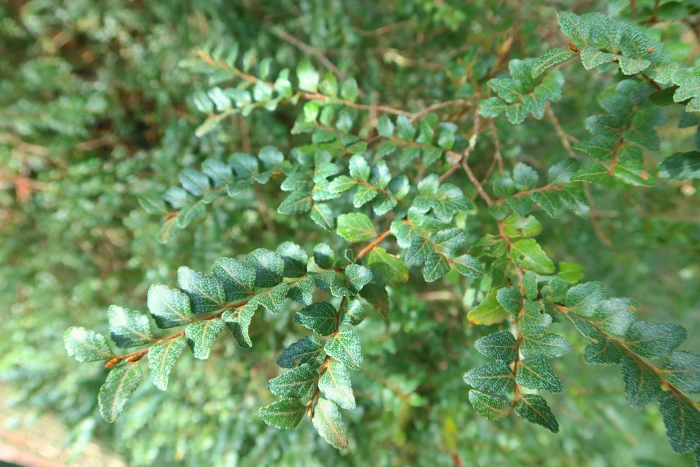Myrtle Beech
(Nothofagus cunninghamii)
Myrtle Beech (Nothofagus cunninghamii)
/
/

Kiri Bee
CC BY 4.0
Image By:
Kiri Bee
Recorded By:
Copyright:
CC BY 4.0
Copyright Notice:
Photo by: Kiri Bee | License Type: CC BY 4.0 | License URL: http://creativecommons.org/licenses/by/4.0/ | Rights Holder: Kiri Bee | Publisher: iNaturalist | Date Created: 2020-09-24T14:44:58-07:00 |















































Estimated Native Range
Climate Requirements for West Lafayette, Indiana
| This Plant | Your Site | Plant Suitability for Your Location | ||
|---|---|---|---|---|
| • Precipitation | 23" - 112" | 37" | Aquatic | Aquatic |
| • High Temp. | 59°F - 84°F | 86°F | Your summers may be too hot for this plant. | Too hot |
| • Low Temp. | 23°F - 45°F | 16°F | Your winter temperatures may be too cold for this plant | Too cold |
This plant should grow well at your location with about N inches per year (Y minutes per month) of irrigation.
Summary
Nothofagus cunninghamii, commonly known as Myrtle Beech, is an evergreen tree native to the cool temperate rainforests of Tasmania and Victoria, Australia. It typically attains a height of 30-40 meters with a trunk diameter up to 1.5 meters. The tree’s form is characterized by a straight trunk and a dense, rounded crown. The bark is rough and often hosts a variety of mosses and epiphytic plants, adding to its ecological value. The leaves are dark green, with new growth emerging in brilliant shades of red, pink, or orange in spring, creating a striking display. Myrtle Beech produces inconspicuous flowers in November and December, which are followed by small, woody capsules.
Myrtle Beech is valued for its lush foliage and the ability to create a dense canopy, making it suitable for creating shaded areas in parks and large gardens. It is also used for its timber, which is prized for fine woodworking. The tree is relatively easy to grow from fresh seed, which germinates within a few weeks. In cultivation, it prefers part shade but can tolerate full sun if provided with sufficient water. It thrives in moist, well-draining soils and can withstand a temperature range from 45 °C (113 °F) to −7 °C (19 °F). However, it may be susceptible to root rot in poorly draining soils and can suffer from leaf spot diseases.CC BY-SA 4.0
Myrtle Beech is valued for its lush foliage and the ability to create a dense canopy, making it suitable for creating shaded areas in parks and large gardens. It is also used for its timber, which is prized for fine woodworking. The tree is relatively easy to grow from fresh seed, which germinates within a few weeks. In cultivation, it prefers part shade but can tolerate full sun if provided with sufficient water. It thrives in moist, well-draining soils and can withstand a temperature range from 45 °C (113 °F) to −7 °C (19 °F). However, it may be susceptible to root rot in poorly draining soils and can suffer from leaf spot diseases.CC BY-SA 4.0
Plant Description
- Plant Type: Tree
- Height: 70-150 feet
- Width: 40-80 feet
- Growth Rate: Rapid
- Flower Color: N/A
- Flowering Season: Spring
- Leaf Retention: Evergreen
Growth Requirements
- Sun: Part Shade
- Water: Medium
- Drainage: Medium
Common Uses
Low Maintenance
Natural Habitat
Cool temperate rainforests of Tasmania and Victoria, Australia
Other Names
Common Names: Tasmanian Myrtle
Scientific Names: Fagus cunninghamii, Nothofagus cunninghamii, Lophozonia cunninghamii
GBIF Accepted Name: Nothofagus cunninghamii (Hook.) Oerst.